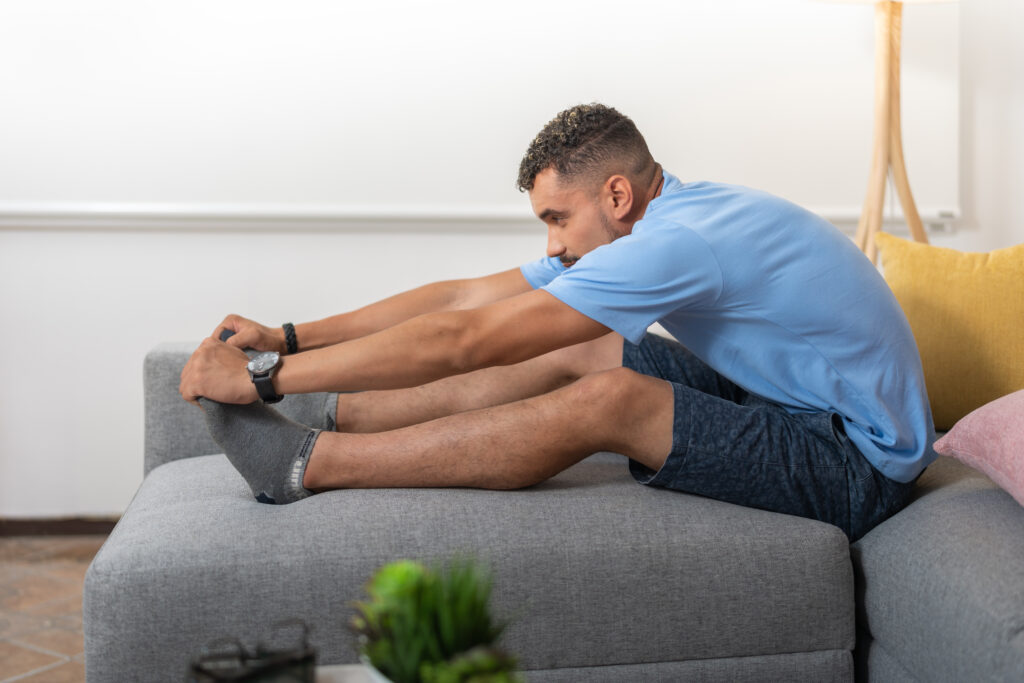Sports are a fantastic way to stay active and maintain a healthy lifestyle. However, athletes of all levels of experience and age can develop sports related back pain. While many cases of back pain can be treated with rest, ice, and over-the-counter medication, some cases require medical attention. Understanding the types of sports-related back pain, identifying the signs of serious problems, and seeking medical help promptly can prevent long-term damage. It is also important to know if and when it is possible to return to the game you love. This is why I like to educate my patients, so they know the symptoms and what we can do to relieve any pain they may be experiencing.
Types of Sports-Related Back Pain
Sports related back pain can manifest in various ways, and recognizing the type of pain is essential for diagnosis and treatment.
Acute Back Pain
Sudden and often caused by an injury such as a fall or a collision, acute back pain can be severe and debilitating, lasting from a few days to several weeks.
Chronic Back Pain
Lasting for more than three months, chronic back pain can be mild or severe and may be caused by an underlying medical condition or injury. Chronic back pain can significantly affect an athlete’s quality of life and ability to participate in sports.
Referred Pain
This is pain that is felt in a different part of the body than where the injury or problem is located. Referred pain can be challenging to diagnose but is important to identify its source for effective treatment.
Common Injuries That Cause Sports-Related Back Pain
Muscle strains and sprains: Muscle strains and sprains are injuries to the muscles and ligaments, respectively. They are common in sports that involve sudden movements or twisting, such as football, basketball, and soccer. A strain occurs when a muscle is overstretched or torn, while a sprain is a stretch or tear in a ligament. These injuries can cause pain, swelling, and reduced range of motion. It’s important for athletes to warm up properly and use correct techniques to minimize the risk of strains and sprains.
Herniated disc: A herniated disc is a condition where the soft tissue between the vertebrae of the spine ruptures or bulges out. This can exert pressure on the nerves in the spine, resulting in pain, numbness, and weakness in the legs. It can occur due to excessive strain, such as lifting heavy weights, or through repetitive movements and poor posture. Athletes, especially in sports like weightlifting or golf that involve twisting and bending, should be cautious and use proper form to avoid this injury.
Spinal stenosis: Spinal stenosis is characterized by the narrowing of spaces within the spine, which can put pressure on the nerves that travel through the spine. This condition can cause pain, numbness, and muscle weakness in the legs. It is commonly seen in older adults due to degeneration, but can also be a result of overuse in certain sports. Athletes in sports that involve repetitive impact, like running, should be aware of this condition and take preventative measures.
Spondylolisthesis: Spondylolisthesis occurs when a vertebra in the spine slips forward onto the bone below it. This can cause nerve compression and result in pain or numbness. It can be caused by a sports injury, such as a stress fracture, or degenerative changes in the spine. Gymnasts, football players, and weightlifters, who repeatedly overstretch their spines, are at risk for this condition. Proper training and strengthening of the supporting back muscles can help in preventing spondylolisthesis.
Compression fractures: Compression fractures in the spine occur when the bone in the vertebrae collapses or fractures due to a sudden impact or stress. This is common in sports that involve high-impact movements or heavy lifting, such as gymnastics or weightlifting. It can cause severe pain and decrease in height. Athletes should ensure they use proper techniques and avoid overexertion to minimize the risk of compression fractures.
Traumatic injuries: These include fractures, dislocations, and other injuries that occur due to a direct blow or impact to the back. They are common in contact sports such as football and hockey, where collisions are frequent. Traumatic injuries can be severe and lead to chronic pain or disability. Wearing appropriate protective gear and adhering to safety rules are essential in minimizing the risk of traumatic injuries in contact sports.
Identifying Signs of Serious Sports-Related Back Pain
While most sports-related back pain can be treated with rest and over-the-counter medication, some cases require medical attention.
Numbness or weakness in the legs: This could indicate a herniated disc or spinal cord injury, which can lead to permanent damage if untreated. A herniated disc occurs when the soft material inside a spinal disc protrudes through the outer layer, potentially pressing on nerves. Spinal cord injuries may result from trauma or degeneration.
Loss of bladder or bowel control: This condition occurs when the bundle of nerves at the lower end of the spinal cord is compressed. It is considered a medical emergency, requiring immediate intervention to prevent permanent damage, including paralysis or loss of function in the lower extremities.
Pain that doesn’t improve with rest or medication: This could include chronic conditions like degenerative disc disease, arthritis, or even infections. It is important to consult a healthcare professional for an assessment, as timely intervention can be crucial in managing the condition effectively.
Pain that wakes you up at night: Nighttime pain can be associated with conditions such as spinal tumors, infections, or certain types of arthritis. Seeking medical evaluation is essential to determine the cause and initiate appropriate treatment.
Pain that radiates down the legs: Pain that spreads from the back down to the legs can be symptomatic of conditions such as a herniated disc or spinal stenosis. Spinal stenosis is the narrowing of the spinal canal, which can put pressure on the nerves. This radiating pain is often termed sciatica, as it commonly affects the sciatic nerve. It is important to consult a healthcare professional for diagnosis and treatment to alleviate symptoms and address the underlying cause.
Treatment Options for Sports-Related Back Pain
The treatment for sports-related back pain depends on the type of injury and the severity of the pain. Some of the most common treatment options include:
Rest and Ice
Resting the back and applying ice can help reduce inflammation and relieve pain. Applying an ice pack or a bag of frozen vegetables, such as peas, to the affected area for 15-20 minutes is a good place to start.
Physical Therapy
Physical Therapy can help improve strength and flexibility in the back and prevent future sports related back pain. A physical therapist can work with patients to develop a personalized exercise plan that focuses on stretching, strengthening, and conditioning the back muscles. This can also help improve posture and body mechanics, reducing the risk of future injury.
Medication
Over-the-counter pain medication, such as ibuprofen and acetaminophen, can help relieve sports related back pain and inflammation. In some cases, prescription medication may be necessary, especially for chronic back pain.
Steroid Injections
Steroid injections are a type of medical treatment that can be used to help reduce inflammation and relieve pain in the back caused by sports-related injuries. These injections deliver a powerful anti-inflammatory medication directly into the affected area, which can help to reduce swelling, pain, and discomfort. Steroid injections are often used for chronic back pain that has not responded to other forms of treatment and can provide long-lasting relief for patients.
Surgery
In extreme cases, surgery may be necessary to treat sports related back pain. This is often the case for herniated discs, spinal stenosis, and spondylolisthesis. However, surgery is usually considered a last resort after other non-invasive treatments have failed.

Preventing Sports-Related Back Pain
At The Institute for Comprehensive Spine Care, we believe prevention is always better than cure, and this is especially true when it comes to sports related back pain. Here are some tips to help you prevent sports-related back pain.
Warm-Up Before Exercising
Taking the time to warm up your muscles before exercising or participating in sports can help reduce the risk of injury. A good warm-up routine should last for at least 10-15 minutes and should involve low-intensity activities such as stretching, jogging, or light aerobic exercise. This will help to increase blood flow to the muscles, making them more pliable and less prone to injury.
Wear Proper Equipment
Wearing proper equipment, such as supportive shoes or a back brace, can go a long way in preventing sports-related back pain. Proper equipment can provide support to your back muscles and joints, reducing the risk of injury. Make sure to wear the right type of equipment for the sport you are participating in, and make sure it fits properly.
Use Proper Technique
Using proper techniques when participating in sports can help reduce the risk of injury. This means using the correct form and posture when performing specific movements, such as bending, twisting, or lifting. If you are unsure about the proper technique, consider taking lessons from a qualified coach or personal trainer.
Stay Hydrated
Dehydration can make your muscles more prone to injury, so make sure to drink plenty of water before, during, and after exercise. While the amount of water you need each day varies according to a few different factors, eight glasses is a good goal to aim for.
Get Regular Exercise
Regular exercise can help strengthen the back muscles and prevent future injuries. Aim to exercise for at least 30 minutes a day, five days a week. This can include low-impact activities such as walking, swimming, or cycling.
Returning to Sports After Surgery
Understand the Risks
It is important for you to understand the risks associated with returning to sports after back surgery. If you return to sports too soon after surgery, you are at risk of re-injuring your back, which could lead to long-term damage. Returning to sports before the body has fully healed can result in muscle imbalances, which can increase the risk of future injury. It may take several months before you can safely return to sports.
Get Clearance
Before you can return to sports after back surgery, you need to get clearance from me. I will evaluate your condition and determine whether it is safe for you to return to sports. You should not return to sports until I give you the green light. It is important to note that the time required to recover varies for each person, and I will provide personalized instructions based on your individual needs.
Start Slowly
When you return to sports after back surgery, you need to start slowly. You should not jump back into your previous level of activity right away. Instead, you should start with low-impact exercises and gradually increase the intensity over time. For example, if a you previously played tennis, you may start with light hitting practice and gradually build up to full matches. You should also listen to your body and stop if you experience any pain or discomfort.
Focus on Core Strength
Core strength is essential for maintaining good posture and balance. If you have undergone back surgery, you need to focus on strengthening your core muscles, as this will help reduce the risk of re-injury. The core muscles consist of the abdominals, back muscles, and pelvic floor muscles. Weak core muscles can lead to poor posture and spinal misalignment, which can cause back pain.
Avoid High-Impact Activities
High-impact activities, such as running and jumping, can put a lot of stress on the back and increase the risk of re-injury. You should avoid high-impact activities until I give you the green light. Instead, focus on low-impact activities, such as swimming, cycling, or yoga. These activities provide a great workout without putting undue stress on the back.
Gradually Increase Intensity and Frequency
As you start to feel more comfortable with low-impact exercises, you can gradually increase the intensity and frequency of your workouts. You should aim to exercise for at least 30 minutes a day, five days a week. You should also track your progress and adjust their exercise routine as needed.
Take Breaks and Rest When Needed
Be aware of your limits and take breaks when needed. Over-exercising can lead to muscle fatigue and increase the risk of re-injury. You should also make sure to get plenty of rest to allow your body to recover from exercise.
Listen to Your Body
Listening to your body is essential when returning to sports after back surgery. You should pay attention to any pain or discomfort and adjust your exercise routine accordingly.

Game On!
If you’re experiencing sports related back pain, schedule a consultation today, and don’t let it keep you on the bench any longer. At The Institute for Comprehensive Spine Care, we provide personalized treatment plans that reduce pain, increase mobility, and improve overall quality of life.
We prioritize clear communication and personalized attention for each of our patients, working with them to develop a comprehensive treatment plan that addresses their specific needs and goals.
















